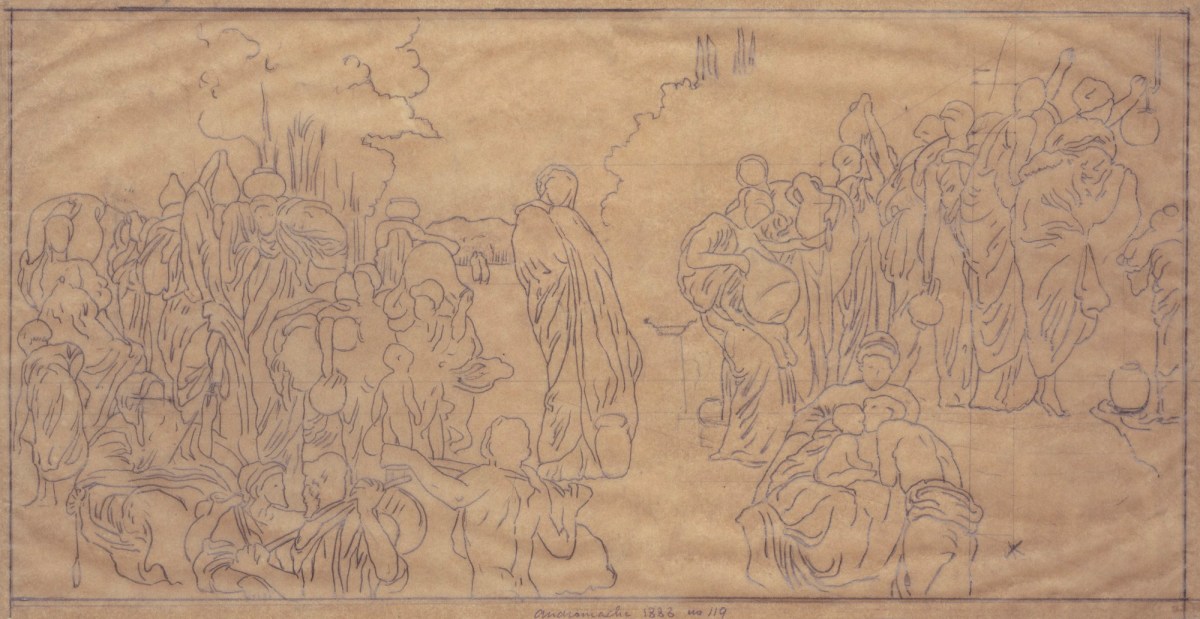
Lord Leighton PRA, Tracing for 'Captive Andromache', ca. 1886-8.
Pencil on tracing paper. 198 mm x 391 mm. © Photo: Royal Academy of Arts, London.
This image is not available to download. To licence this image for commercial purposes, contact our Picture Library at picturelibrary@royalacademy.org.uk
Tracing for 'Captive Andromache', ca. 1886-8
Lord Leighton PRA (1830 - 1896)
RA Collection: Art
A pencil tracing for 'Captive Andromache' (ca.1886-8, Manchester City Art Galleries). Although precisely drawn in outline, the architecture and landscape background are only faintly suggested and this tracing differs somewhat from the composition of the finished oil painting. There are a number of horizontal, vertical and diagonal lines lightly drawn over the tracing where Leighton was working out the perspective of the picture.
The general composition remains the same in both cases, showing the unfortunate Andromache isolated in the centre of the picture flanked on either side by groups of women carrying water and washing clothes. However, there are a number of significant differences in the detail. Firstly, the tracing shows a frontally posed Andromache but Leighton eventually altered this to accentuate the sense of this figure's isolation and inactivity. In the finished painting, he presented a motionless, preoccupied Andromache, her dark cloak drawn around her, facing the right hand side of the canvas with her head bowed and her face in profile. Leighton later developed this melancholic pose in a painting which deals with similar themes of grief and loss, 'Lachrymae' (1895, Metropolitan Museum, New York).
Secondly, the presence of a larger number of figures in the tracing shows that Leighton pared down the composition for the final painting. In the tracing there are two extra figures at the washing trough on the right, another two carrying water on the left, and two small figures looking over a wall in the distance. Removing these figures rendered the composition less frenetic and more elegant while retaining the sense of industrious activity around the still, central figure.
Thirdly, without the background and architecture, the composition appears as a swirl of figures on the left leading diagonally up to the top right hand corner. In the finished composition, this has been flattened out to produce a less dynamic but more balanced effect, befitting the melancholic subject. Lastly, the tracing omits the significant figure of the girl on the left of Andromache (apparently painted from Leighton's young model Lena Pullen). Another tracing for the composition, in the Leighton House Collection, shows a slightly later stage of the picture's development, including Andromache in the final pose, but retaining the extra figures and omitting Lena Pullen.
Leighton claimed to have worked on the composition from 1886-8, making over 50 drawings in preparation. However, a thumbnail sketch for the composition in Leighton House appears on the same sheet as studies for 'Hercules Wrestling with Death for the Body of Alcestis' (1869-71, Wadsworth Athenaeum, Connecticut) suggesting that he first conceived the composition up to two decades previously.
These tracings all relate to Leighton's painting 'Captive Andromache' (c.1886-8, Manchester City Art Galleries). The subject of the painting is loosely based on a passage in Homer's Iliad in which the Trojan leader, Hector, reflects on the possible fate of his wife, Andromache, if he were to be killed. In the text, Hector remarks to his wife 'I see you there in Argos, toiling for some other woman at the loom, or carrying water from an alien well, a helpless drudge with no will of your own' (trans E.V. Rieu, 1950, p. 129).
The painting was exhibited with a quotation from Elizabeth Barrett Browning's translation of The Iliad:
'Some standing by,
Marking thy tears fall, shall say 'This is she,
The wife of that same Hector that fought best
Of all the Trojans when all fought for Troy.'
These tracings include four studies for the composition, one for a group of figures and one of a Greek vase. Unusually, two of the compositional tracings differ significantly from the finished painting. One appears to be an alternative, or early, version of the scene while the other includes many more figures than the final composition. The tracings also indicate that Leighton experimented with the pose of Andromache, who is shown in a frontal pose in one of these earlier versions. In the finished painting, the sense of Andromache's detachment and melancholic contemplation is accentuated by her profile pose.
Object details
198 mm x 391 mm
Start exploring the RA Collection
- Explore art works, paint-smeared palettes, scribbled letters and more...
- Artists and architects have run the RA for 250 years.
Our Collection is a record of them.



